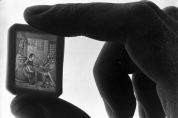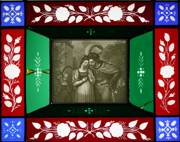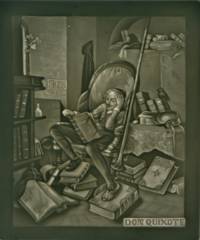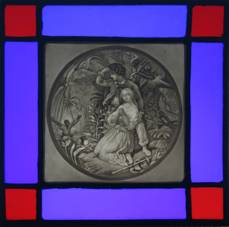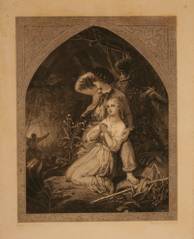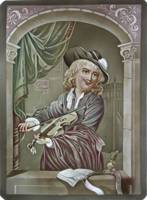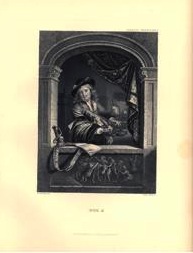Captured in Porcelain
Special Exhibition April 28 – October 28, 2012
There are so many ways to enjoy a good story. One can read a story in a book or on a Kindle; view it on a flat screen television or a Smartphone; or hear it via a DVD or iPod. Another option is to witness the story magically appear in a rare 19th century lithophane when the porcelain plaque is illuminated from behind. There are more than 2,360 such opportunities at the Blair Museum of Lithophanes. While every lithophane has a story associated with its image, some lithophanes are based on popular stories and are literally Captured in Porcelain. These three-dimensional porcelain plaques mounted in candle shields, night lights, tea warmers, lanterns, beer steins, and stained glass to be hung in sunlit windows, feature stories of comedy, romance, tragedy, and even a minuet-serenading violinist. Favorite stories that are portrayed in lithophanes include that of the French gypsy Esméralda and her dancing goat Djali (pronounced Jellee), fictional characters from Victor Hugo’s 1831 novel The Hunchback of Notre Dame. Some lithophane images of Esméralda include Quasimodo lurking in a corner. At least two 19th century lithophanes are based on an engraving by Jean-Pierre-Marie Jazet in 1841, which is a copy of a painting by Charles de Steuben (French, 1788-1856). The Royal Porcelain Manufactory in Berlin also created a lithophane of Esméralda. With the backstamp KPM 255 St., this large plaque, measuring 12.125” x 9.625” depicts Esmeralda hugging her goat, and it is also based on an oil painting by Steuben. A Gothic style candle shield with a Plaue lithophane marked PPM 251 was inspired by the same Steuben painting. The story involving Scheherazade centers around the Persian King Shahryar’s belief that all his wives would betray him like his first wife. He married a new virgin each day, and beheaded each the next morning. Scheherazade volunteered to stay with the King one night, and the dawn came before she had finished her story. So he spared her life each day in order for her to finish the next night. After one thousand and one nights, and one thousand and one stories, she finished the stories, they had fallen in love, and had three sons. Ultimately a wiser and kinder man, the King spared her life and she became his Queen. The lithophane image of Scheherazade from The Arabian Nights, mounted in a candle shieldwhich was created at the Meissen factory in Dresden in the mid-19th century is based on a painting titled Ali Pasha and Kira Vassiliki by Paul Emil Jacobs (German, 1802-1866) created in 1848. The novel Paul et Virginie (Paul and Virginia) was published in 1788 by the French writer Jacque-Henri Bernadin de Saint-Pierre. It tells the story of two children raised by their mothers on the tropical island of Mauritus. The girl, Virginie, is sent to France to be educated. She thinks only of marrying Paul. On her return voyage, the ship is wrecked off the island coast and she drowns. Paul dies of grief. The story is an “indictment of the corruption of modern Europe and an elegy for the lost Edenic childhood innocence of mankind.” (Dennis Wood, French Literature Companion). The illustrations/engravings from the book are the direct inspiration for the lithophanes. The Blair Museum owns at least eleven lithophane versions of Paul et Virginie in porcelain. Some are square, rectangular, trapezoid and oval plaques. Others are mounted in stained glass or part of a fairy lamp or a lampshade. While all lithophanes tell a story, all of the lithophane images chosen for this special exhibition include depictions of stories that were popular in the 19th century. Some are still popular today. The story of Reynard the Fox, first published several hundred years ago, was the subject of two enchanting lithophanes produced in Germany in the 19th century, based on text by Goethe (Reinecke Fuchs) and illustrations by engraver Wilhelm Kaulbach. Yet these sometimes horrific tales of the fox tricking (and some times eating!) his fellow woodland creatures, are the subject of more than one picture book that can be found at your local public library’s childrens room. The whole story, involving romance and intrigue, will be shared by a willing docent when you visit the Blair Museum during the special exhibition Captured in Porcelain. In the mid-19th century, the German company Plauesche Porzellan-Manufaktur issued a small lithophane titled Don Quixote based on an 1834 oil painting by Adolf Schroedter (German, 1805-1875) titled Don Quijote im Lehnstuhl lesend (Don Quixote Reading in the Armchair). Other stories that will be shared include a lithophane and engravings of Auld Robin Gray which originated from the Scots ballad written in 1772; captivating images of Gretchen (or Marguerite) and Faust; and more storied surprises from our collection. Captured in Porcelain opens with a public reception from 2-4 p.m. on April 28, 2012 and will remain on view through October 28, 2012. For more information visit www.lithophanemuseum.org. |
Lithophane, Esméralda, German, 19th century, Berlin, KPM 255 St, Blair Museum no. 980, 12.125” x 9.625”.
Lithophane in stained glass, Paul and Virginie, German, 19th century, unmarked, Blair Museum no. 82, lithophane 3.25” x 3.25”, frame 5.25” x 5.375”.
Engraving of Paul and Virginie from the Blair Museum Archives.
Lithophane, title unknown, German, 19th century, marked BPM 578, Blair Museum no. 9, 9.525” x 3.875”.
Engraving of G. Dow by W. French from the Blair Museum of Lithophanes Archives. |

